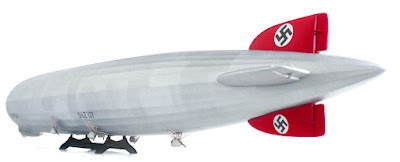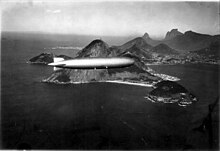Here are some images of Lindberg/Hawk 1/245 scale Graf Zeppelin.
From Wikipedia"
LZ 127 Graf Zeppelin (Deutsches Luftschiff Zeppelin #127; Registration: D-LZ 127) was a German-built and -operated, passenger-carrying, hydrogen-filled, rigid airship which operated commercially from 1928 to 1937. When it entered commercial service in 1928, it became the first commercial passenger transatlantic flight service in the world. It was named after the German pioneer of airships, Ferdinand von Zeppelin, who was a count (Graf) in the German nobility. During its operating life, the airship made 590 flights covering more than 1.7 million kilometers (over 1 million miles). It was designed to be operated by a crew of 36 officers and men. The LZ 127 was the longest rigid airship at the time of its completion and was only surpassed by the USS Akron in 1931. It was scrapped for fighter plane parts in 1940.
Built at the Zeppelin Company works (Luftschiffbau Zeppelin) in Friedrichshafen am Bodensee (Lake Constance), Germany, between 1926 and 1928, the LZ-127 had a design patterned on that of the LZ-126, which the company had delivered as a war reparation to the U.S. Navy. The LZ-126 had been delivered at NAS Lakehurst, New Jersey, in October 1924, where it was commissioned as the USS Los Angeles (ZR-3).[2] With that project completed, the Zeppelin company's chairman Dr. Hugo Eckener promptly began a two-year campaign of lobbying the German Government for funds and permission to proceed with construction of a new airship for Germany. Construction began in 1926 with the aid of a government grant although the majority of the necessary 2 million Reichsmarks (RM) in funding would eventually be raised by public subscription. The LZ 127 was completed and launched in September 1928.
At 236.6 m (776 ft) and a total gas volume of 105,000 m3 (3,700,000 cu ft) of which 75,000 m3 (2,600,000 cu ft) was hydrogen carried in 17 "lift gas" cells (Traggaszelle) and 30,000 m3 (1,100,000 cu ft) was Blau gas in 12 "power gas" cells (Kraftgaszelle), the Graf was the largest airship in the world at the time. It was powered by five Maybach VL-2 12-cylinder 550 hp engines that could burn either Blau gas or gasoline.
Although the Graf could achieve a top airspeed of 128 km/h (36 m/s; 80 mph; 69 kn) at its maximum power of 1,980 kW (2,650 hp), its normal operational airspeed was 117 km/h (33 m/s; 73 mph; 63 kn) at a power of 1,600 kW (2,150 hp). Some flights were made using only Blau gas carried in the dozen power gas cells which enabled the airship to cruise for up to 100 hours. Using gasoline alone it was able to cruise for 67 hours, and up to 118 hours using both. The Graf Zeppelin had a total lift capacity of 87,000 kg (192,000 lb) with a usable payload of 15,000 kg (33,000 lb) on a 10,000 km (6,200 mi; 5,400 nmi) flight.
The LZ 127 was christened Graf Zeppelin by Countess Brandenstein-Zeppelin on 8 July 1928, the 90th anniversary of the birth of her father Ferdinand. The Zeppelin Company had originally planned to charter LZ 127 to a Spanish company to carry mail from Seville in Spain to Buenos Aires, Argentina, and a contract was signed just before the first flight of the airship with the intention to carry out test flights between Spain and Argentina in 1929.
The Graf Zeppelin's operational career spanned almost nine years from first flight in September 1928 until its last in June 1937. During that period, the airship was operated first by the Zeppelin Company's commercial flight arm, the Deutsche Luftschiffahrts-Aktiengesellschaft (German Airship Travel Corporation, DELAG) in conjunction with the Hamburg-American Line (HAPAG), and for the final two years by the Deutsche Zeppelin Reederei GmbH (DZR), a company established by Hermann Göring in March 1935 to increase Nazi party influence over Zeppelin operations. The DZR was jointly owned by the Luftschiffbau Zeppelin, the Reichsluftfahrtministerium (German Air Ministry), and Deutsche Lufthansa A.G., Germany's national airline at that time.
Other flights were also made to Spain London, Berlin and Moscow. During one of the Berlin visits a glider that was released from under its hull performed a loop in front of cheering crowds,and on one of the Brazil trips British Pathé News filmed on board.
Flown German "First 1934 South America Flight" cover
During the airship's operational career, the Graf Zeppelin flew more than 1.7 million km (1,056,000 miles), becoming the first aircraft in history to fly over a million miles, made 590 flights, 144 oceanic crossings (143 across the Atlantic, one across the Pacific), carried 13,110 passengers, and spent 17,177 hours aloft (the equivalent of 717 days, or nearly two years), all of which was accomplished without ever injuring a passenger or crewman. Although scrapped in 1940, hundreds of thousands of verifiable philatelic mementos of its career still exist in the form of the flown cacheted and post marked mail carried on hundreds of its flights which are still avidly collected by stamp and postal history enthusiasts worldwide.
It was in its last five years of service that Graf Zeppelin proved that an intercontinental commercial airship service was possible. For those five years it operated regular scheduled services during the summer season between Germany and South America. The Zeppelin Company built a large hangar in Rio de Janeiro, then Brazil's capital city, the construction of which was subsidized by the Brazilian government. Designed and assembled with parts brought from Germany, the hangar was used only nine times: four by the Graf and five by the LZ-129 Hindenburg.
LZ 127 Graf Zeppelin over Rio de Janeiro
The loss of the D-LZ 129 Hindenburg at Lakehurst on 6 May 1937 shattered public faith in the safety of hydrogen-filled airships making the continuation of their commercial passenger operations unsustainable unless the Graf Zeppelin and the still under construction LZ 130 Graf Zeppelin II could convert to non-flammable helium, the only alternative lifting gas for airships. Unlike the relatively inexpensive and universally available hydrogen, however, the vast majority of the world's available supplies of the much more costly, less buoyant, and harder to produce helium (which is an extracted byproduct of mined natural gas) were controlled by the United States. Since 1925, the exportation of helium had also been tightly restricted by Congress, although there is no record that the German Government had ever applied for an export license for helium to use in its airships prior to the Hindenburg's crash and fire.
Though much safer than hydrogen, the greatly added expense, lack of availability, and overall degradation in lifting performance that converting to helium would impose on the Graf Zeppelin made its continued operation no longer commercially viable. One day after the Hindenburg crashed in Lakehurst, the nine-year-old LZ 127 was grounded and withdrawn from service on its arrival in Friedrichshafen after a flight from Brazil on 8 May 1937. Six weeks later, on 18 June, the airship was ferried to Frankfurt am Main on what would be its 590th and final flight. On its arrival at its massive hangar at the Frankfurt airport, the airship was deflated and opened to the public as a museum.
The Graf Zeppelin had already been decommissioned and retired after the Hindenburg disaster, when President Roosevelt approved and forwarded a Cabinet report to Congress that supported exporting enough helium to Germany to permit the launched Hindenburg Class LZ-130 Graf Zeppelin II, which was designed to use either hydrogen or helium, to resume commercial transatlantic passenger service by 1939. By early 1938, however, firm opposition by Interior Secretary Harold Ickes, formally made in his capacity of one of the six statutory members of the National Munitions Control Board, to a German request to purchase up to 10,000,000 cubic feet (280,000 m3) of helium made that impossible.
Established by §5(a) of the Neutrality Act of May 1, 1937 (22 U.S.C. 441), the Board (which consisted of the Secretaries of State, War, Navy, Treasury, Commerce, and Interior), was vested by the Act with the ultimate authority to both prohibit the export to "belligerent states, or to a state wherein civil strife exists" of any type of "arms, ammunition, and implements of war" as well as restrict the transfer of any other "articles or materials" such as helium which the Government classified as having "military importance."
At a White House press briefing on 11 May 1938, President Roosevelt's press secretary Stephen Early announced that as the Act required the "unanimous" consent of the Control Board to approve the export of helium to Germany, the President had concluded that he was "without legal power to override the judgment of any one of the six [members] and direct the sale of helium for export." In response to this statement, Dr. Eckener commented later that same day that "should this decision be final, I am afraid it means the death sentence for commercial lighter-than-air craft."
Although the Graf Zeppelin II made 30 test, promotional, propaganda and military surveillance flights around Europe between the airship's launch in mid-September 1938 and its last flight 11 months later on 20 August, made just 10 days before the formal start of World War II in Europe with the German invasion of Poland on 1 September 1939, the LZ 130 never entered the commercial passenger service for which it was built. The ultimate fates of both the original Graf Zeppelin (LZ 127) and the Graf Zeppelin II (LZ 130) were formally sealed on 4 March 1940, when German Air Minister Hermann Göring issued a decree ordering both to be immediately scrapped for salvage and their duralumin airframes and other structures to be melted down for reuse by the German military aircraft industry.






























